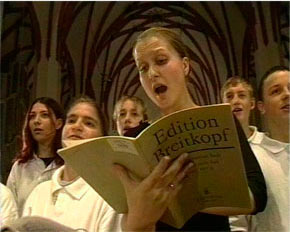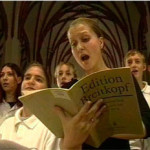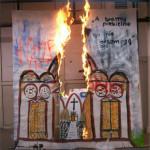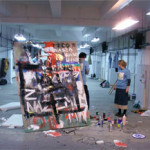By JENNIFER MCMACKON
The current exhibition at Toronto's Gallery TPW was curated by the gallery's Programming Director, Kim Simon. It features two video works by Polish artist, Artur Zmijewski.
The first of these, Singing Lesson 2, (2003) plays on a medium sized flat screen monitor very nearly at the entrance to the gallery. On the monitor a choir of young people appear to be singing in church. As one seats oneself and pulls a set of headphones over one's ears, strains of remotely familiar music, specifically (I glean later) Bach's Cantata, Heart and Lips and Deed and Life are awash in haunting noises emanating from the choir which is composed of hearing impaired children. The piece is mesmerizing. Though the choir seems locked in a visual embrace with the conductor, his gestures evince only atonal sighing, growling and sobbing - sounds far more gutteral and far less self conscious than anyone in the hearing world would commonly ascribe to a hymn sing. The result is a very peculiar, dreadful yet beautiful noise.
Allusive meanings seem bound up in this excercise but (to North American eyes and ears anyway) they unfold haltingly, as a kind of uneasy feeling. In the essay accompanying the exhibition, the words of Daniel Baird go a long way to provide a context for the piece:
[...] Singing Lesson 2 feels haunted by the combination of purity and brutality that is German history. "[E]ither the world is dumb/or I am deaf," the great Polish poet Zbigniew Herbert writes, "but perhaps/we are both/doomed to our afflictions." The upshot of Zmijewski's work may be that we are doomed to our afflictions.
It may be that we are all doomed to our afflictions. But as the singers and the conductor greet each other with hugs and smiles and kisses at the end of the performance, one can't help but bask in the glimmer of warmth that comes when this doom is shared.
In the main gallery another, more recent work by Zmijewski called Them (2007) is projected on a large wall with sound playing throughout the space and English subtitling. Them is set in a nondescript warehouse studio in Warsaw. To this space the artist invites individuals from such diverse Polish social groups as devout Catholic women, a Gay and Lesbian group, a Socialist group and a Nationalistic Youth group Ð charging them with the task of creating an emblematic image of Poland. Perhaps predictably and with broad strokes, the Catholic ladies make a painting of a church, the Youth group, an upright sword and so on.
The logos are completed and the rest of the video proceeds over the course of a number of successive meetings in which the factions are encouraged to make changes to the displeasing elements of each other's works. Members of each group arrive wearing a tee-shirt bearing the icon from their original mural. At first, the groups make rather polite, seemingly innocuous improvements to each other's creations. The doors of the painted church are cut open with scissors for example. A rainbow symbolizing peace is taped over the sword. As the meetings continue, however, the interventions with the various logos become more and more surgically destructive. The sword is cut from the painting and added to a symbolic "rubbish heap of history". Then it is revived with a swath of paper adhered from behind.
At some point each of the murals seems to be entirely covered in gooey paint or otherwise suffering an indignity at the hands of iconoclasts. The environment becomes fractious and voices are raised as the emblems endure more and more destructive 'modifications'. In the end two of the works get tossed right out the window like cumbersome paper airplanes. Then there is an altercation involving scissors, in which one woman declares , "I have a very different vision of the world than you do." This is followed by a liberal sprinkling of lighter fluid and finally... there is a fire. Them, which was created for last summer's (2007) Documenta is as tersely didactic as cautionary tales get.
- Artur Zmijewski, video stills from Singing Lesson 2, 2003.
- Artur Zmijewski, video still from Them, 2007.
- Artur Zmijewski, video still from Them, 2007.
Artur Zmijewski's work was presented at Gallery TPW as part of Toronto's 21st Annual Images Festival.
All images are courtesy of the artist and Gallery TPW.







